Influence of Material Removal Strategy on Machining Deformation of Aluminum Plates with Asymmetric Residual Stresses
Abstract
1. Introduction
2. Materials and Methods
2.1. Simulation Section
2.1.1. Assumption of Numerical Simulation
2.1.2. Geometric Model and Material Parameters of Numerical Simulation
2.2. Experimental Section
2.2.1. Experimental Materials
2.2.2. Spray Quenching Experiment
2.2.3. Characterization Method of Residual Stress and Deformation
3. Results and Discussions
3.1. Residual Stress Distribution of the Asymmetrical Spray Quenching
3.2. Residual Stress and Deformation under Different Machining Strategies and Initial Stress States
3.2.1. Model and Material Removal Strategy
3.2.2. Effect of Machining Strategies on the Distribution of Residual Stress and Deformation
3.2.3. Coupling Effect of Machining Strategies and Initial Stress States on the Distribution of Machining Deformation
4. Conclusions
- (1)
- With the reduction in the spray flow rate following spray quenching, the stress level in thick aluminum alloy plates also decreased. As the difference in spray flow rate between the two sides steadily widened during asymmetric spray quenching, the stress level in the core of the thick plate gradually migrated toward the high spray flow surface. The simulation model and the starting stress states were accurate, as shown by the good agreement between the simulation and experimental data.
- (2)
- The final machining distortion of the thick plate could be significantly decreased by using an appropriate material removal approach. The maximum deformation could be reduced by 95% when the top 3 mm of material was removed. Moreover, the deformation results of the machining experiment proved the accuracy of the simulation results.
- (3)
- Under the same machining strategy, the lower the stress level of the plate, the smaller the final deformation. Under the T3+B7 machining strategy, the deformation at the bottom of the frame changed from a “convex” shape to a “concave” shape because of the asymmetry of stress levels. Meanwhile, the deformation of the part was significantly smaller when the frame-mouth was oriented towards the high-stress level.
Author Contributions
Funding
Institutional Review Board Statement
Data Availability Statement
Conflicts of Interest
References
- Gloria, A.; Montanari, R.; Richetta, M.; Varone, A. Alloys for Aeronautic Applications: State of the Art and Perspectives. Metals 2019, 9, 662. [Google Scholar] [CrossRef]
- Heinz, A.; Haszler, A.; Keidel, C.; Moldenhauer, S.; Benedictus, R.; Miller, W.S. Recent development in aluminium alloys for aerospace applications. Mater. Sci. Eng. A 2000, 280, 102–107. [Google Scholar] [CrossRef]
- Pantelakis, S.G.; Alexopoulos, N.D. Assessment of the ability of conventional and advanced wrought aluminum alloys for me-chanical performance in light-weight applications. Mater. Des. 2008, 29, 80–91. [Google Scholar] [CrossRef]
- Fereiduni, E.; Ghasemi, A.; Elbestawi, M. Selective Laser Melting of Aluminum and Titanium Matrix Composites: Recent Progress and Potential Applications in the Aerospace Industry. Aerospace 2020, 7, 77. [Google Scholar] [CrossRef]
- Liu, L.; Sun, J.; Chen, W.; Sun, P. Study on the machining distortion of aluminum alloy parts induced by forging residual stresses. Proc. Inst. Mech. Eng. Part B J. Eng. Manuf. 2017, 231, 618–627. [Google Scholar] [CrossRef]
- Bi, Y.-B.; Cheng, Q.-L.; Dong, H.-Y.; Ke, Y.-L. Machining distortion prediction of aerospace monolithic components. J. Zhejiang Univ. A 2009, 10, 661–668. [Google Scholar] [CrossRef]
- Li, J.-G.; Wang, S.-Q. Distortion caused by residual stresses in machining aeronautical aluminum alloy parts: Recent advances. Int. J. Adv. Manuf. Technol. 2017, 89, 997–1012. [Google Scholar] [CrossRef]
- Fu, S.; Feng, P.; Ma, Y.; Wang, L. Initial residual stress measurement based on piecewise calculation methods for predicting machining deformation of aeronautical monolithic components. Int. J. Adv. Manuf. Technol. 2020, 108, 2063–2078. [Google Scholar] [CrossRef]
- Xiaoyue, L.I.; Liang, L.I.; Yinfei YA, N.G.; Guolong ZH, A.O.; Ning, H.E.; Xiaocen, D.I.N.G.; SHI, Y.; Fan, L.; Lan, H.; Jamil, M. Machining deformation of single-sided component based on finishing allowance optimization. Chin. J. Aeronaut. 2020, 33, 2434–2444. [Google Scholar]
- Huang, X.; Sun, J.; Li, J. Finite element simulation and experimental investigation on the residual stress-related monolithic com-ponent deformation. Int. J. Adv. Manuf. Tech. 2015, 77, 1035–1041. [Google Scholar] [CrossRef]
- Husson, R.; Dantan, J.-Y.; Baudouin, C.; Silvani, S.; Scheer, T.; Bigot, R. Evaluation of process causes and influences of residual stress on gear distortion. CIRP Ann. 2012, 61, 551–554. [Google Scholar] [CrossRef]
- Gao, H.; Zhang, Y.; Wu, Q.; Li, B. Investigation on influences of initial residual stress on thin-walled part machining deformation based on a semi-analytical model. J. Mater. Process. Technol. 2018, 262, 437–448. [Google Scholar] [CrossRef]
- Zhang, L.; Feng, X.; Li, Z.; Liu, C. FEM simulation and experimental study on the quenching residual stress of aluminum alloy 2024. Proc. Inst. Mech. Eng. Part B J. Eng. Manuf. 2013, 227, 954–964. [Google Scholar] [CrossRef]
- Yinfei YA, N.G.; Longxin FA, N.; Liang, L.I.; Guolong, Z.H.A.O.; Ning HA, N.; Xiaoyue, L.I.; Tian, H.; He, N. Energy principle and material removal sequence optimization method in machining of aircraft monolithic parts. Chin. J. Aeronaut. 2020, 33, 2770–2781. [Google Scholar]
- Landwehr, M.; Oehler, F.; Behnken, H.; Holling, H.; Sambathkumar, R.; Ganser, P.; Bergs, T. Influence of heat treatment on the residual stress-related machining distortion of Ti-6Al-4V alloy monolithic parts. Procedia CIRP 2021, 104, 1328–1333. [Google Scholar] [CrossRef]
- Yang, Y.; Li, M.; Li, K.R. Comparison and analysis of main effect elements of machining distortion for aluminum alloy and titanium alloy aircraft monolithic component. Int. J. Adv. Manuf. Technol. 2014, 70, 1803–1811. [Google Scholar] [CrossRef]
- Javidikia, M.; Sadeghifar, M.; Songmene, V.; Jahazi, M. On the impacts of tool geometry and cutting conditions in straight turning of aluminum alloys 6061-T6: An experimentally validated numerical study. Int. J. Adv. Manuf. Technol. 2020, 106, 4547–4565. [Google Scholar] [CrossRef]
- Wu, Q.; Li, D.P.; Zhang, Y.D. Detecting milling deformation in 7075 aluminum alloy aeronautical monolithic components using the quasi-symmetric machining method. Metals 2016, 6, 80. [Google Scholar] [CrossRef]
- Li, B.; Jiang, X.; Yang, J.; Liang, S.Y. Effects of depth of cut on the redistribution of residual stress and distortion during the milling of thin-walled part. J. Mater. Process. Technol. 2015, 216, 223–233. [Google Scholar] [CrossRef]
- Soori, M.; Asmael, M. Mechanical Behavior of Materials in Metal Cutting Operations: A Review. J. New Technol. Mater. 2020, 10, 79–89. [Google Scholar] [CrossRef]
- Wang, B.; Liu, Z.; Song, Q.; Wan, Y.; Ren, X. A Modified Johnson–Cook Constitutive Model and Its Application to High Speed Machining of 7050-T7451 Aluminum Alloy. J. Manuf. Sci. E-T Asme. 2019, 28, 6958–6968. [Google Scholar] [CrossRef]
- Casuso, M.; Polvorosa, R.; Veiga, F.; Suárez, A.; Lamikiz, A. Residual stress and distortion modeling on aeronautical aluminum alloy parts for ma-chining sequence optimization. Int. J. Adv. Manuf. Tech. 2020, 110, 1219–1232. [Google Scholar] [CrossRef]
- Zhang, Z.; Li, L.; Yang, Y.; He, N.; Zhao, W. Machining distortion minimization for the manufacturing of aeronautical structure. Int. J. Adv. Manuf. Technol. 2014, 73, 1765–1773. [Google Scholar] [CrossRef]
- Zhu, K.; Xiong, B.; Li, X.; Zhang, Y.; Li, Z.; Li, Y.; Wen, K.; Yan, L. Finite element simulation on residual stress during immersion quenching and pre-stretching of Al7055 thick plates. Mater. Res. Express 2022, 9, 026525. [Google Scholar] [CrossRef]
- Guo, R.; Wu, J.; Fan, H.; Zhan, X. The effects of spray characteristic on heat transfer during spray quenching of aluminum alloy 2024. Exp. Therm. Fluid Sci. 2016, 76, 211–220. [Google Scholar] [CrossRef]
- Xu, R.; Li, L.; Zhang, L.; Zhu, B.; Liu, X.; Bu, X. Influence of pressure and surface roughness on the heat transfer efficiency during water spray quenching of 6082 aluminum alloy. J. Mater. Process. Technol. 2014, 214, 2877–2883. [Google Scholar] [CrossRef]
- Puschmann, F.; Specht, E. Transient measurement of heat transfer in metal quenching with atomized sprays. Exp. Therm. Fluid Sci. 2004, 28, 607–615. [Google Scholar] [CrossRef]
- Duan, Z.; Li, C.; Ding, W.; Zhang, Y.; Yang, M.; Gao, T.; Cao, H.; Xu, X.; Wang, D.; Mao, C.; et al. Milling Force Model for Aviation Aluminum Alloy: Academic Insight and Perspective Analysis. Chin. J. Mech. Eng. 2021, 34, 18. [Google Scholar] [CrossRef]
- Maximov, J.T.; Anchev, A.P.; Duncheva, G.V.; Ganev, N.; Selimov, K.F. Influence of the process parameters on the surface roughness, micro-hardness, and residual stress in slide burnishing of high-strength aluminum alloys. J. Braz. Soc. Mech. Sci. 2017, 39, 3067–3078. [Google Scholar] [CrossRef]

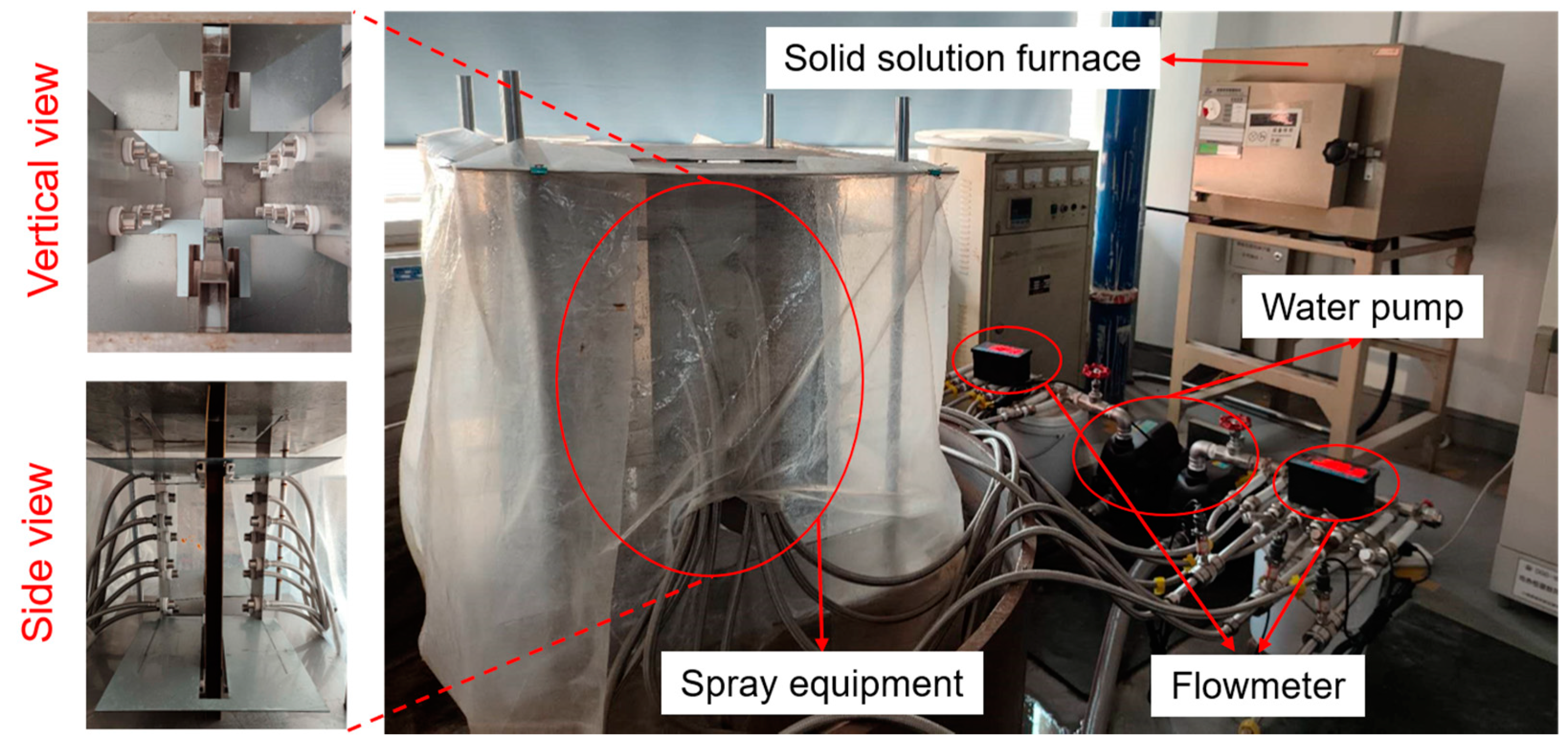





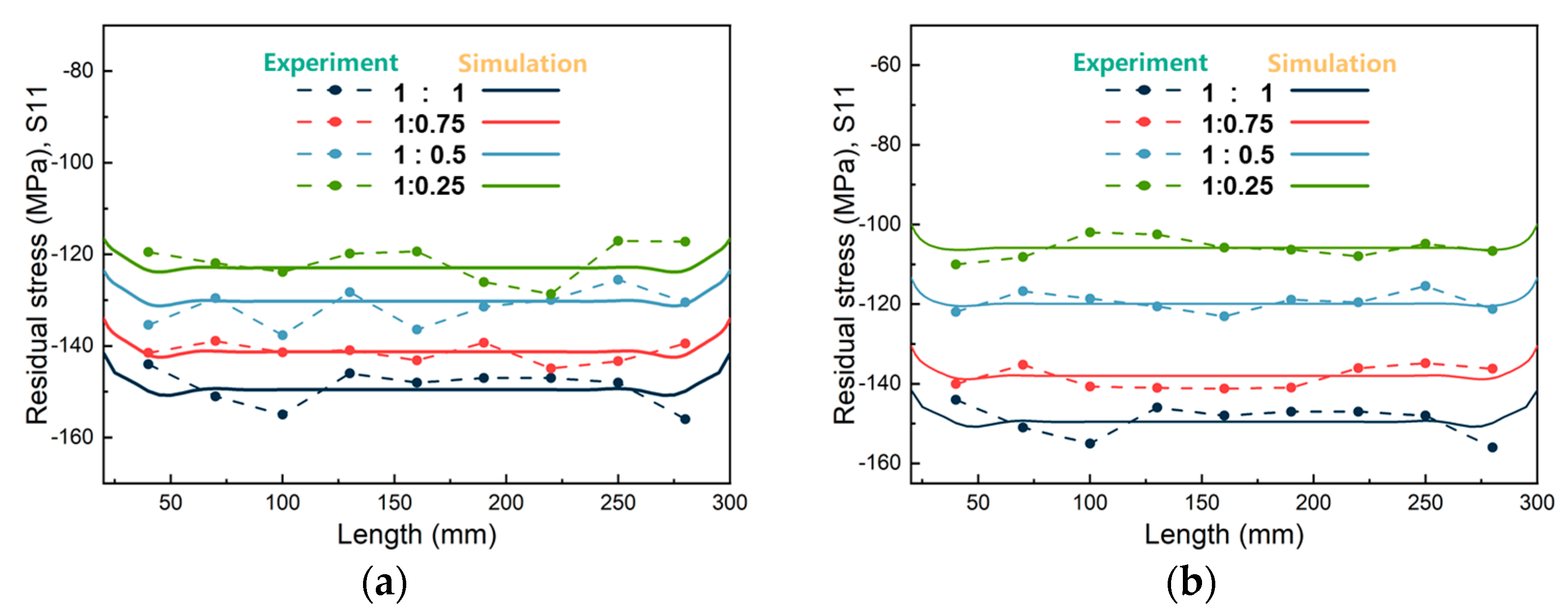
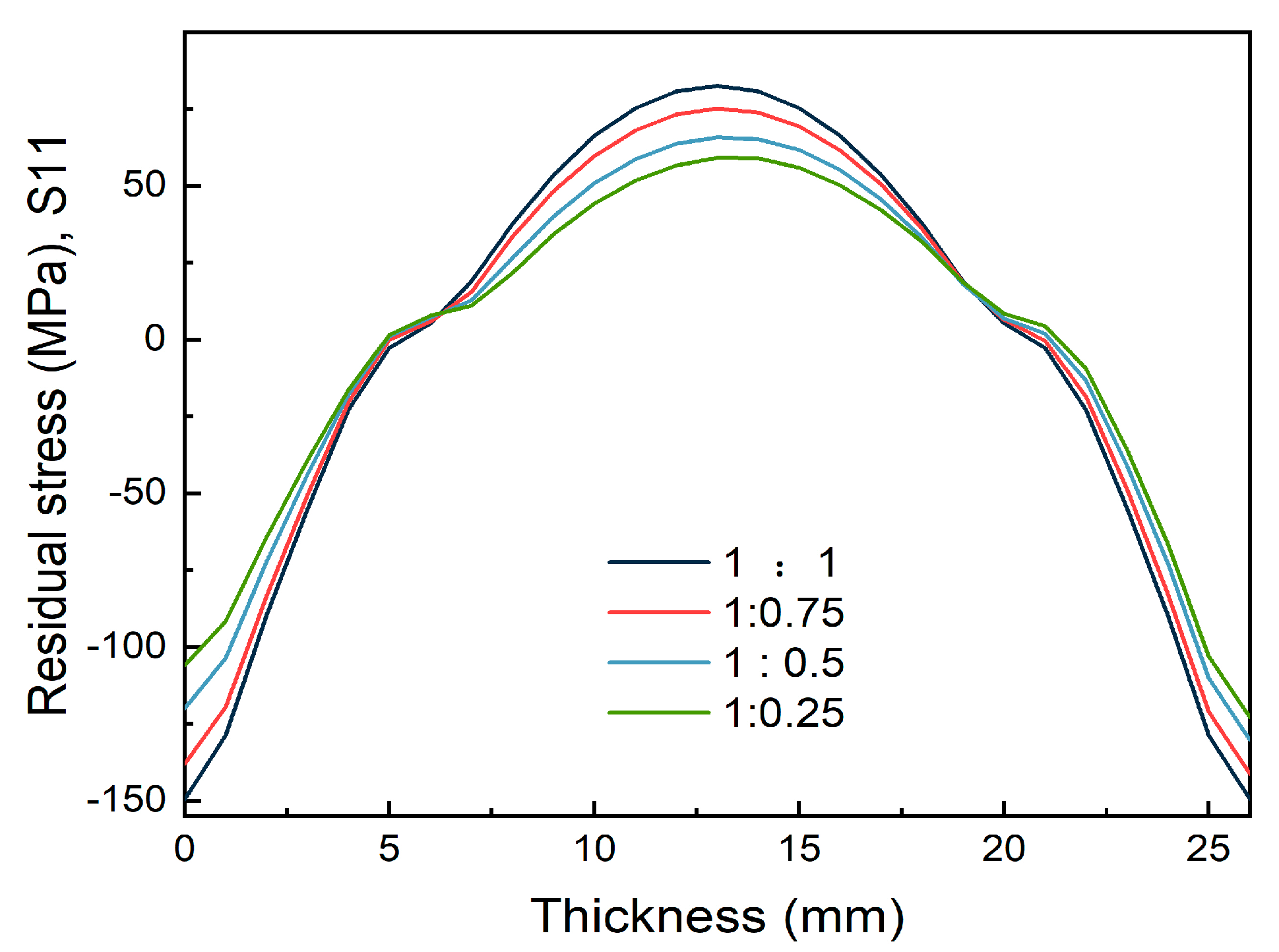

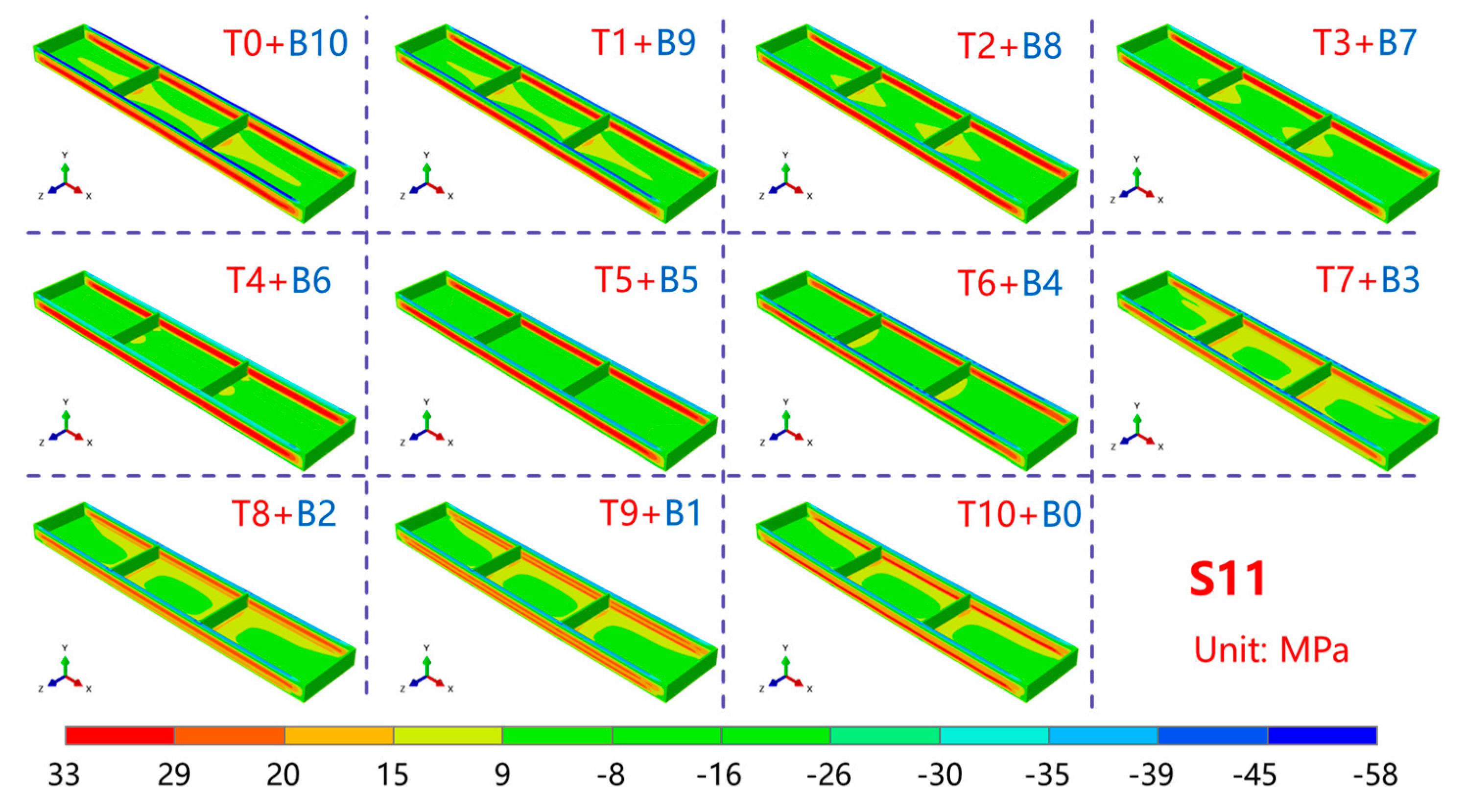




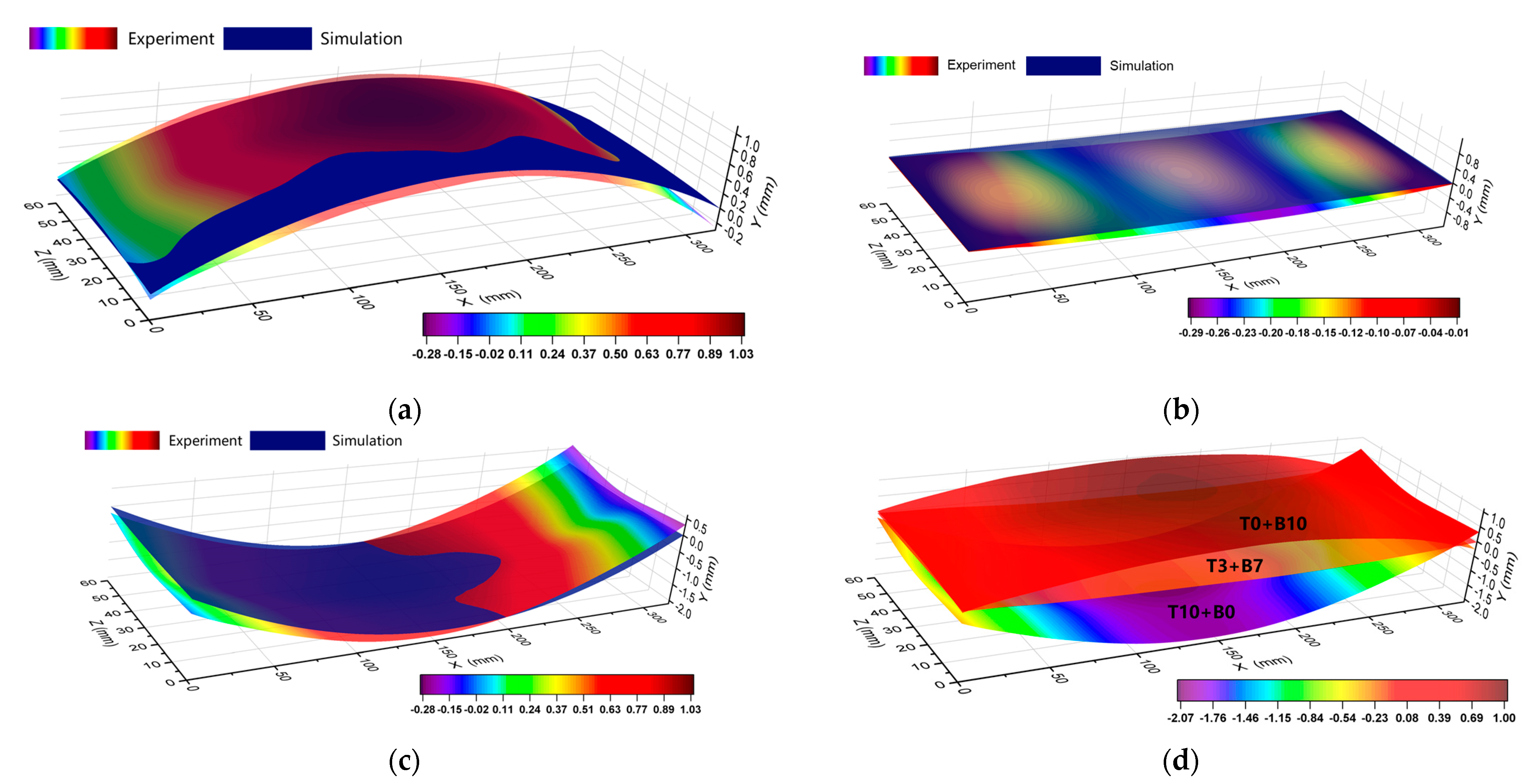
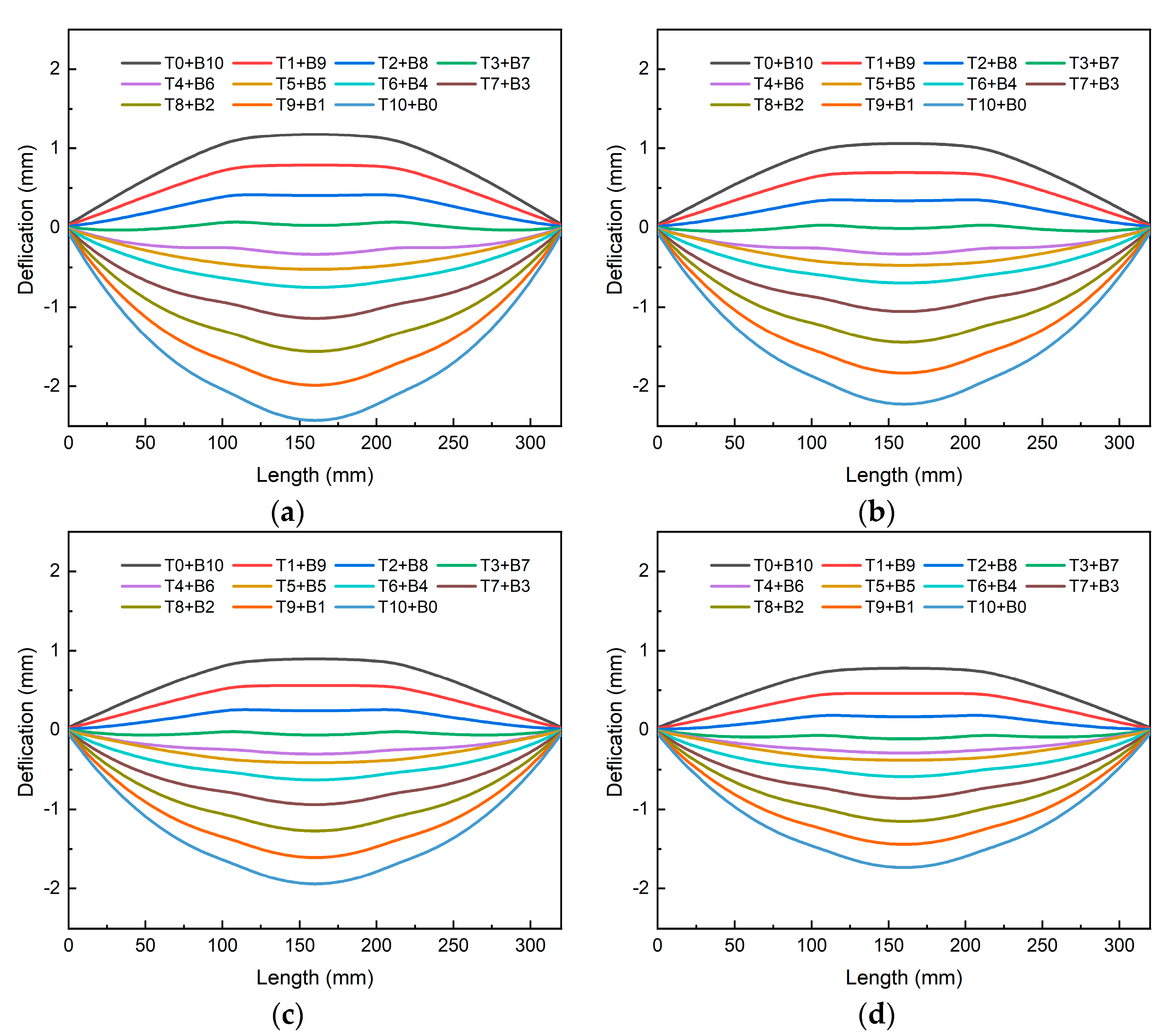

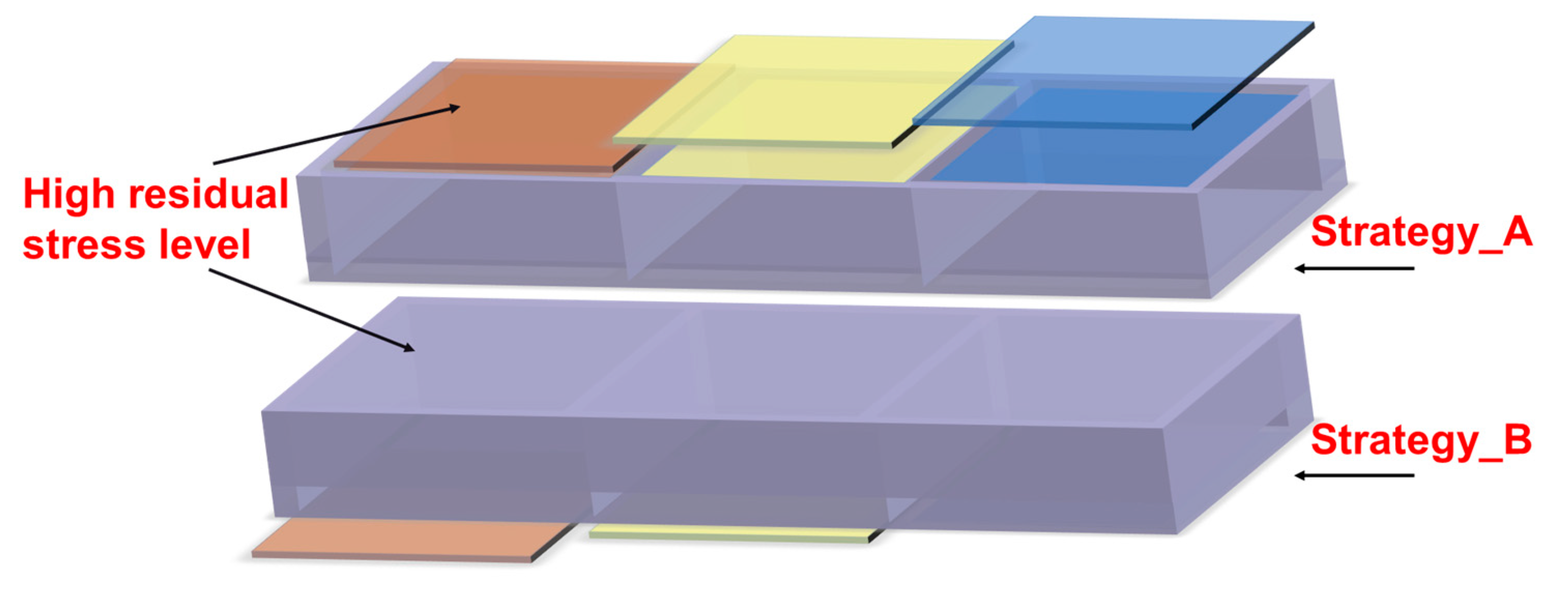
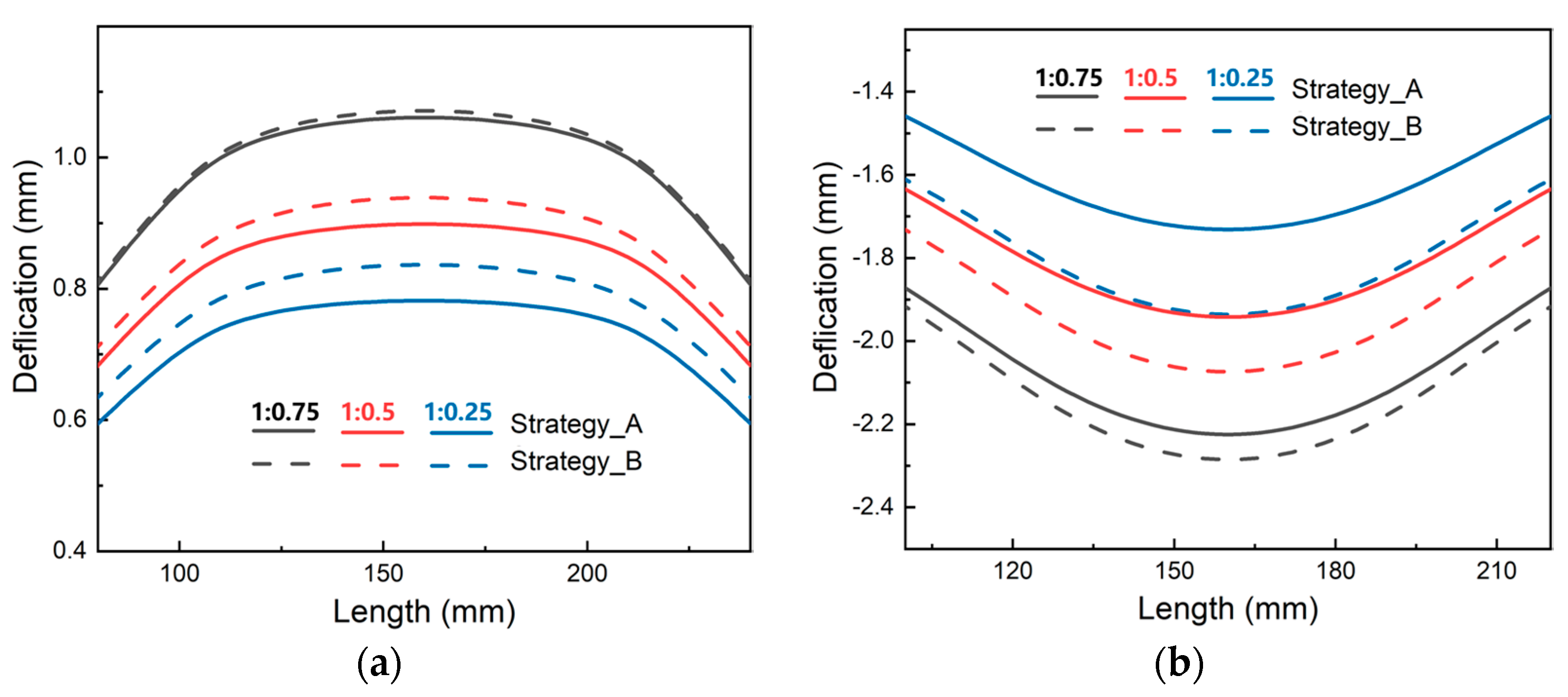
| Temperature (°C) | 20 | 100 | 200 | 300 | 400 | 500 |
|---|---|---|---|---|---|---|
| (kg·m−3) | 2841 | 2828 | 2807 | 2787 | 2761 | 2735 |
| (W·m−1·°C−1) | 126.7 | 133.3 | 179.4 | 179.4 | 191.5 | 175.4 |
| (10−6·°C−1) | 22.7 | 24.0 | 24.2 | 25.2 | 26.0 | 27.5 |
| (J·kg−1∙K−1) | 913 | 983 | 1025 | 1113 | 1292 | 1158 |
| Rp0.2 (MPa) | 266 | 223 | 154 | 73 | 23 | 10 |
| E (GPa) | 73 | 61 | 56 | 38 | 32 | 25 |
| 0.64 | 0.48 | 0.32 | 0.16 | |
| 10,000 | 8000 | 5500 | 4000 |
| Rotation Speed (r·min−1) | 1200 |
|---|---|
| Feed speed (mm·min−1) | 150 |
| Axial cutting depth (mm) | 1 |
| Radial cutting width (mm) | 4 |
| Tool inclination angle | 30° |
| Tool cearance angle | 8° |
Disclaimer/Publisher’s Note: The statements, opinions and data contained in all publications are solely those of the individual author(s) and contributor(s) and not of MDPI and/or the editor(s). MDPI and/or the editor(s) disclaim responsibility for any injury to people or property resulting from any ideas, methods, instructions or products referred to in the content. |
© 2023 by the authors. Licensee MDPI, Basel, Switzerland. This article is an open access article distributed under the terms and conditions of the Creative Commons Attribution (CC BY) license (https://creativecommons.org/licenses/by/4.0/).
Share and Cite
Li, Y.; Li, Y.-N.; Li, X.-W.; Zhu, K.; Zhang, Y.-A.; Li, Z.-H.; Yan, H.-W.; Wen, K. Influence of Material Removal Strategy on Machining Deformation of Aluminum Plates with Asymmetric Residual Stresses. Materials 2023, 16, 2033. https://doi.org/10.3390/ma16052033
Li Y, Li Y-N, Li X-W, Zhu K, Zhang Y-A, Li Z-H, Yan H-W, Wen K. Influence of Material Removal Strategy on Machining Deformation of Aluminum Plates with Asymmetric Residual Stresses. Materials. 2023; 16(5):2033. https://doi.org/10.3390/ma16052033
Chicago/Turabian StyleLi, Yang, Ya-Nan Li, Xi-Wu Li, Kai Zhu, Yong-An Zhang, Zhi-Hui Li, Hong-Wei Yan, and Kai Wen. 2023. "Influence of Material Removal Strategy on Machining Deformation of Aluminum Plates with Asymmetric Residual Stresses" Materials 16, no. 5: 2033. https://doi.org/10.3390/ma16052033
APA StyleLi, Y., Li, Y.-N., Li, X.-W., Zhu, K., Zhang, Y.-A., Li, Z.-H., Yan, H.-W., & Wen, K. (2023). Influence of Material Removal Strategy on Machining Deformation of Aluminum Plates with Asymmetric Residual Stresses. Materials, 16(5), 2033. https://doi.org/10.3390/ma16052033





